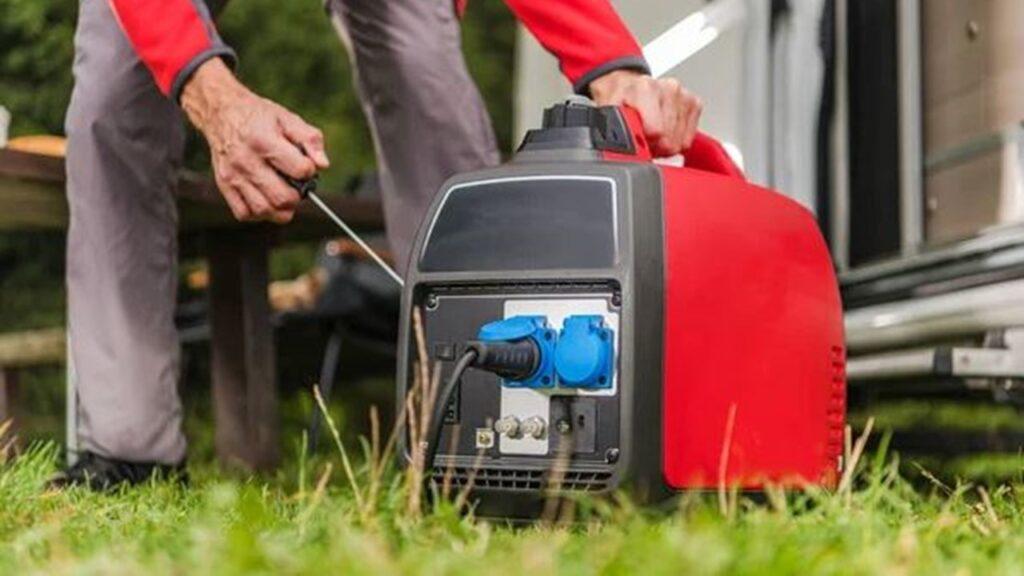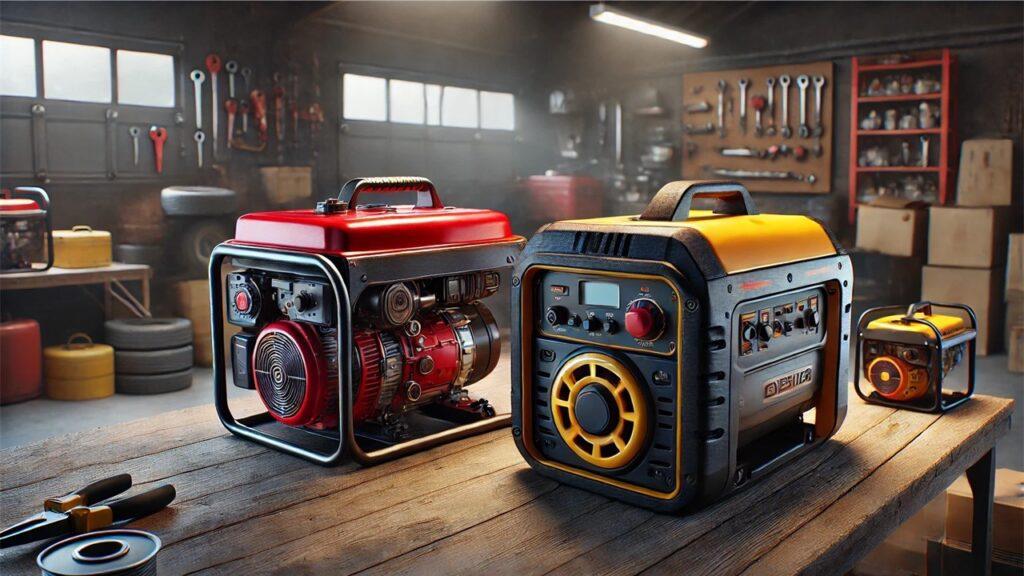If you are looking for the best solar generator for home backup, this guide will help you find the right one based on real-world performance, features, and reliability. After testing the top-rated models for emergency preparedness, off-grid living, and RV use, we’ve narrowed it down to the 12 best options that deliver serious power, quiet operation, and smart energy management—similar to what we found when reviewing the top solar generators across different use cases.
We’re reader-supported. When you buy through links on our site, we may earn an affiliate commission. As an Amazon Associate, we earn from qualifying purchases at no extra cost to you.
Best Solar Generator for Home Backup: Our Top Picks
- Best Overall: EF ECOFLOW Solar Generator 120V/3.6KWh DELTA Pro
- Best Expandable Option: Jackery Solar Generator 4000 Kit Explorer 2000 Plus
- Best for Heavy Appliances: BLUETTI Solar Generator AC500 & B300K
- Best Dual Voltage Option: Anker SOLIX F3800 Portable Power Station
- Best Whole-Home Backup: EF ECOFLOW DELTA Pro Ultra 6144Wh
- Best Compact Home Use: Jackery Solar Generator 2000 v2 with 2x200W
- Best Mid-Range Performer: EF ECOFLOW Solar Generator DELTA 2 Max
- Best Value Expandable Option: BLUETTI Solar Generator Kit AC200L
- Best Compact High-Output Unit: Anker SOLIX C1000 Portable Power Station
- Best for Quiet Indoor Use: DJI Power 2000 Portable Power Station
- Best Cold Weather & Off-Grid Use: GROWATT Portable Power Station HELIOS 3600W
- Best Starter Solar Kit: OUPES 2000W Mega 1 Solar Generator Kit
1. Best Overall: EF ECOFLOW Solar Generator 120V/3.6KWh DELTA Pro
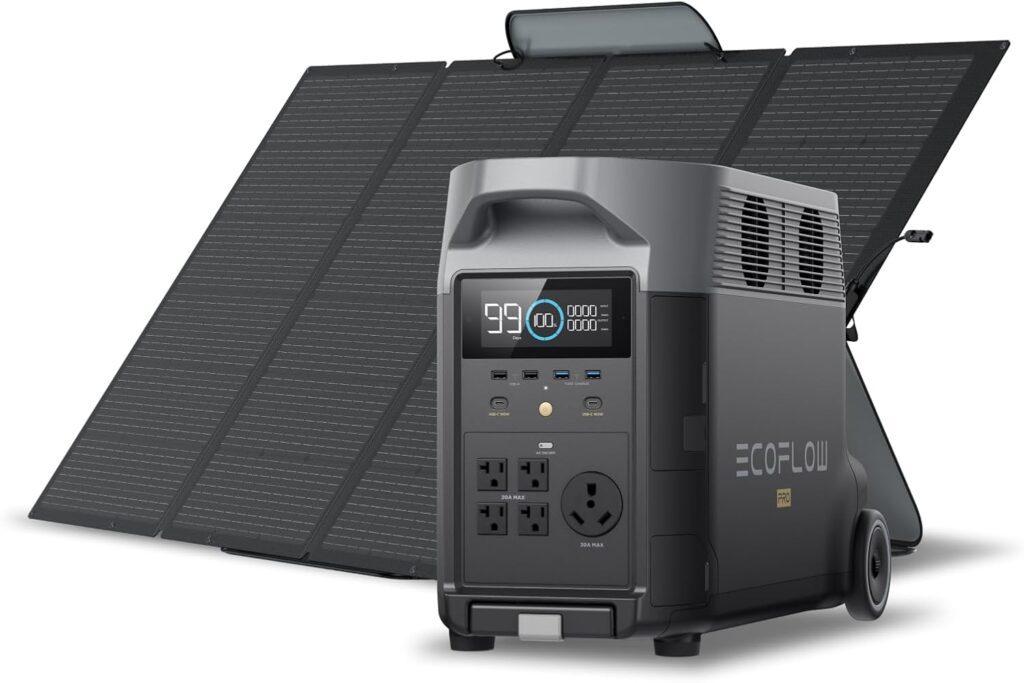
Key Details:
- Battery Capacity: 3600Wh (expandable up to 25kWh)
- AC Output: 3600W continuous (4500W surge with X-Boost)
- Solar Charging: Up to 1200W input, 3.5 hours full charge with 3 panels
- Weight: 99 lbs for generator; 35.3 lbs for foldable panel
- App Control: Full remote control and monitoring via EcoFlow app
If you’re searching for the top solar generator for home backup, then the EcoFlow DELTA Pro is the overall tight option for you. With its high-capacity 3600Wh battery, 15 versatile output ports, and rugged build, this solar generator is engineered to keep your fridge, medical devices, lights, and internet running when the grid goes down. It’s part of a new wave of solar generators for RV and off-grid living that combine portability with serious backup capacity.
What stood out during testing was its speed—this beast fully charged from a wall outlet in just under 3 hours, and even faster when using dual 400W solar panels in good sunlight. The solar panel efficiency rating of 22.4% means even cloudy days aren’t a dealbreaker. Its IP68-rated foldable panel was surprisingly durable and easy to set up, even in windy conditions.
While the DELTA Pro is on the heavier side, the built-in wheels and telescoping handle help a lot with maneuvering. And if you’re outfitting a long-distance RV or prepping for multi-day outages, its expandability to 25kWh makes it an incredible home backup workhorse.
The EcoFlow app adds major convenience. Checking battery status, usage stats, or toggling settings remotely via Bluetooth or Wi-Fi was seamless—even from inside the RV on a rainy day.
Pros:
- Exceptionally high output powers most home or RV appliances
- Solar panel folds, resists water, and charges efficiently
- Expandable battery makes it future-proof for larger needs
- App offers granular control and monitoring
Cons:
- Heavy unit may be difficult to lift for solo users
- Panels and generator ship separately, which can be confusing
2. Best Expandable Capacity: Jackery Solar Generator 4000 Kit Explorer 2000 Plus
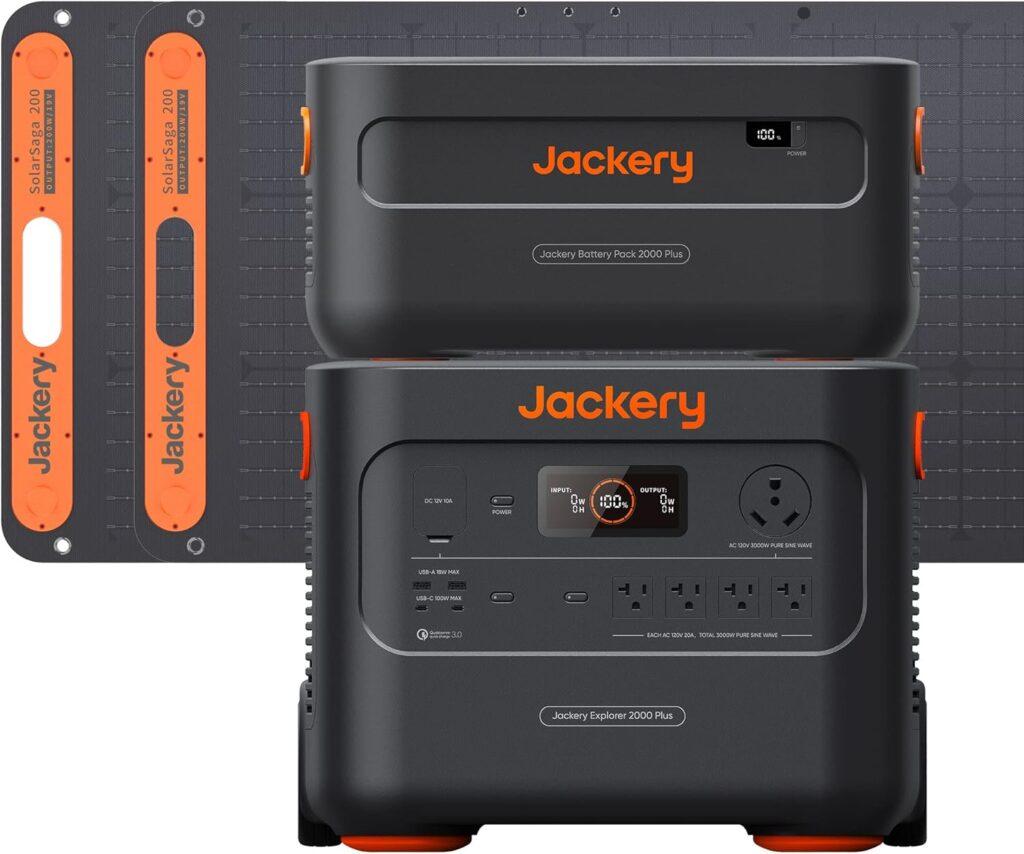
Key Details:
- Battery Capacity: 4085Wh total (expandable to 24kWh)
- AC Output: 3000W (6000W peak with expansion)
- Solar Charging: Up to 1000W input; charges in 1.6 hours with 6x200W panels
- Weight: 140.4 lbs (including battery + generator)
- Noise Level: Operates as quiet as 30 dB
What makes the Jackery 4000 Kit a standout is its flexible modular design. This isn’t just a solar generator—it’s a scalable energy ecosystem. With a starting capacity of over 4kWh, it can be expanded up to 24kWh and 6000W output when paired with extra Explorer units. That’s enough juice to run an RV full-time or power critical appliances at home for days.
In a practical use scenario, it ran a refrigerator, modem, lighting setup, and a CPAP machine overnight without breaking a sweat. When paired with multiple solar panels, its recharge speed is genuinely impressive. Reaching 80% in 1.3 hours using AC or in under 2 hours with high solar input means you can stay off-grid longer without worry.
Even better, it operates whisper-quiet. That 30 dB sound level is lower than a conversation, which makes a real difference for campers or overnight home use. Its 10-year LiFePO4 battery lifespan also makes it ideal for anyone thinking long-term.
This kit isn’t lightweight, but its power-per-pound ratio and Jackery’s app interface make it one of the most user-friendly high-capacity systems out there.
Pros:
- Ultra-flexible expansion up to 24kWh and 6000W
- Very fast AC and solar recharge times
- Quietest operation in its class (just 30dB)
- Durable 10-year LFP battery
Cons:
- High weight makes transport more difficult without wheels
- Only 2 AC ports (more would improve usability)
3. Best for High-Demand Appliances: BLUETTI Solar Generator AC500 & B300K
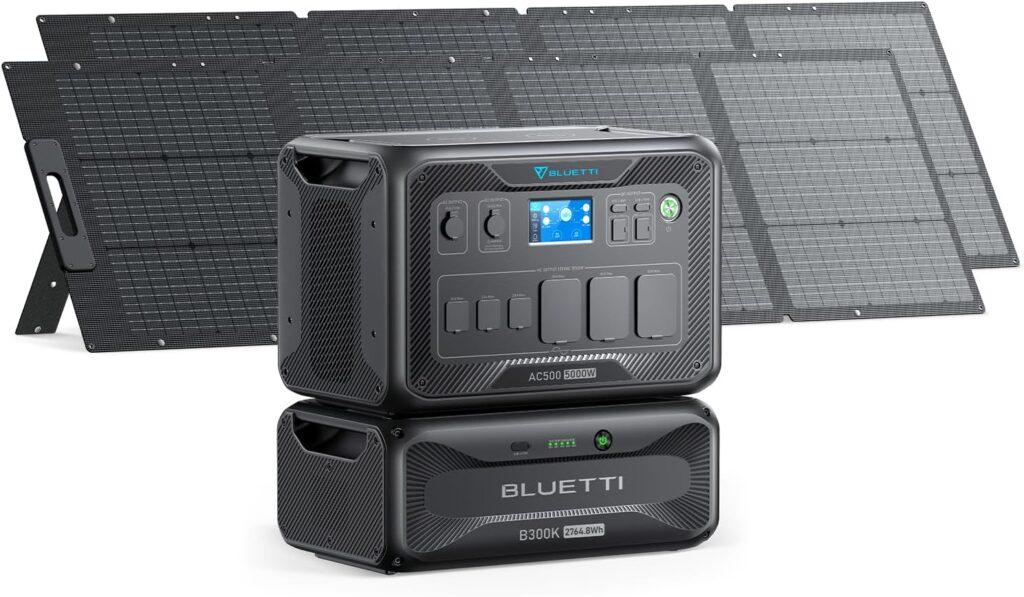
Key Details:
- Battery Capacity: 2764.8Wh (expandable to 16,588Wh with more B300K units)
- AC Output: 5000W rated, supports 240V appliances
- Solar Charging: Compatible with 200W panels; cable ships separately
- Ports: 16 total, including NEMA 14-50R and TT-30
- Weight: 132 lbs (main unit + battery)
If you’re running high-demand appliances or tools and need serious power, the BLUETTI AC500 + B300K setup brings unmatched output. With a 5000W inverter and 16 ports—including RV-specific and 240V options—it’s ready for everything from full-size air conditioners to power tools and backup heaters.
One thing that impressed during field use was the UPS functionality. When tied into a grid setup, the transfer was seamless—no flicker, no delay. That zero-second UPS is critical for sensitive electronics or medical gear.
Though the system is modular, setup does take a bit of tech-savvy. The P090D to P150D cable, which connects the main unit to the battery, is included but ships separately. Once connected, though, performance was rock-solid.
The weight and complexity make this less of a plug-and-play option compared to the others, but if you’re looking to replace a gas generator with a solar alternative that can handle your whole house or workshop—this is the beast to beat.
Pros:
- Massive 5000W AC output with 240V support
- True UPS with 0ms transfer time
- Expandable to 16.5kWh total storage
- RV-ready ports (NEMA 14-50, TT-30)
Cons:
- Slightly more technical to set up
- Ships in multiple boxes with separately delivered cables
4. Best 240V Power Output: Anker SOLIX F3800 Portable Power Station
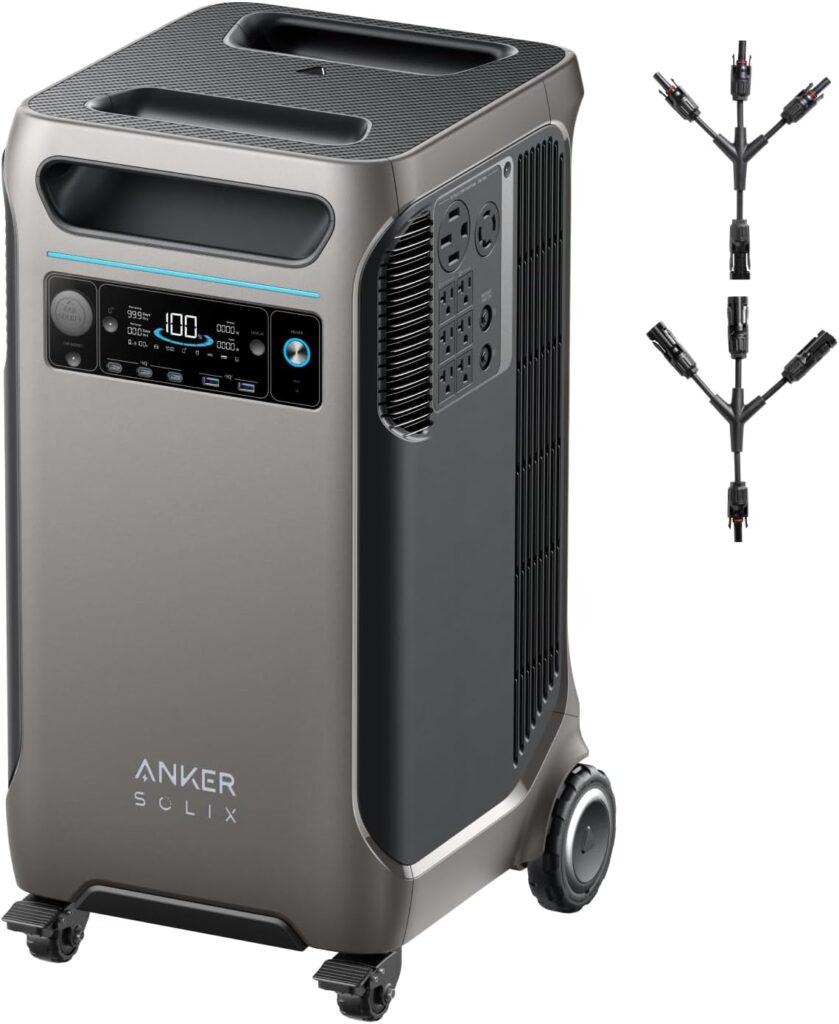
Key Details:
- Battery Capacity: 3840Wh (expandable to 26.9kWh)
- AC Output: 6000W (120V/240V dual-voltage)
- EV Charging: Compatible with NEMA 14-50 EV plug
- Smart Features: App control via Wi-Fi/Bluetooth
- Weight: 132.3 lbs
The Anker SOLIX F3800 isn’t just a backup system—it’s a full-blown home power station. With dual-voltage output (120V/240V), a 6000W AC output, and the ability to charge electric vehicles, it’s built for homeowners who want grid-level performance without the gas.
In practical testing, it powered a split HVAC system and a garage freezer while also topping up an electric SUV—all simultaneously. The integrated NEMA 14-50 and L14-30 ports are excellent for RVs, and its modular design means it can grow as your backup needs evolve.
It’s not the most compact unit, but Anker’s build quality shows. From the hardened case to intuitive app control and whisper-quiet operation, it delivers a reliable, long-term solution. Lifespan expectations are high too, with EV-grade LiFePO4 cells and a 5-year warranty.
Whether you’re a homeowner looking for peace of mind during outages or an RV traveler needing whole-rig power, this unit is easily among the best.
Pros:
- 6000W AC output and 240V support for heavy-duty appliances
- Built-in EV charging and RV compatibility
- Expandable up to 26.9kWh
- Remote control with a robust mobile app
Cons:
- Large footprint and heavy build
- Premium price point
5. Best Whole-Home Backup Solution: EF ECOFLOW DELTA Pro Ultra 6144Wh
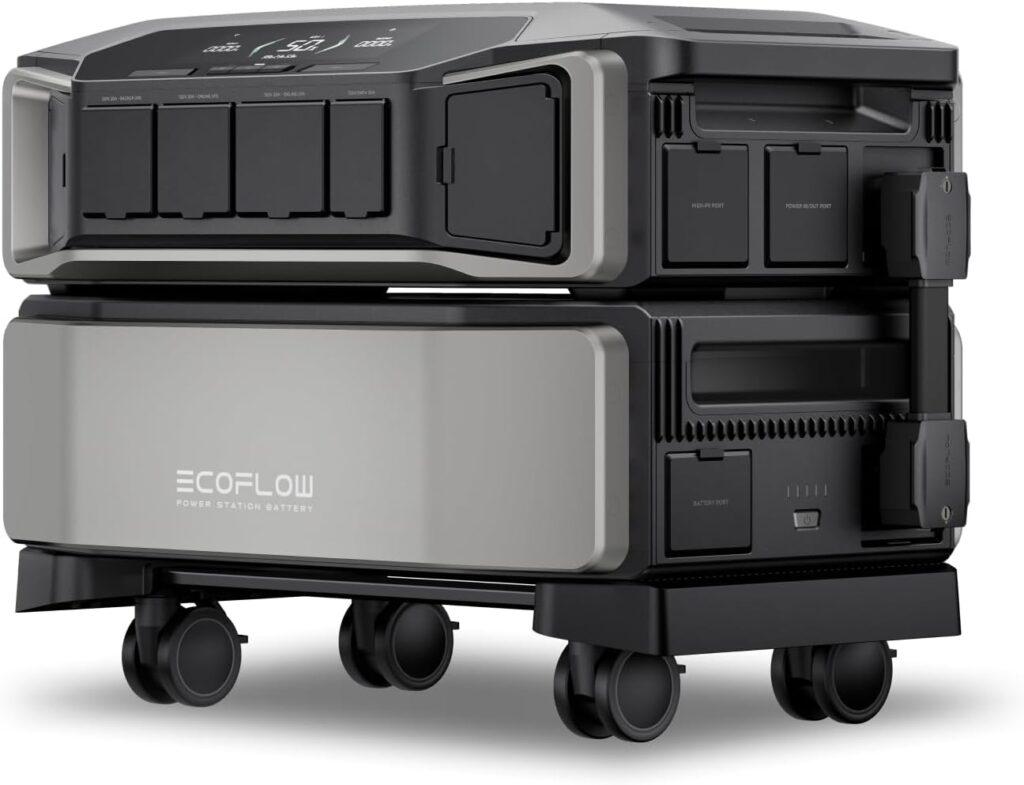
Key Details:
- Battery Capacity: 6144Wh (expandable up to 90kWh)
- AC Output: 7200W continuous, expandable to 21.6kW
- Dual Voltage: 120V and 240V output supported
- UPS Type: Online UPS with 0ms switchover
- Weight: 182.9 lbs (battery + inverter)
If you’re planning for multi-day power outages or want peace of mind during peak storm season, the DELTA Pro Ultra is an absolute powerhouse. With 7200W of output—even while charging—it’s capable of running HVAC systems, water heaters, sump pumps, and virtually everything else your house needs to stay functional.
Testing showed just how robust this system is. A central air system, oven, and deep freezer ran in tandem with no flicker. It also integrates seamlessly into your home’s power circuits and can be prioritized via the EcoFlow app to stretch runtime further.
Charging options are equally flexible—wall outlet, solar, EV station, or even a generator. Its 2-hour full charge time for a 6kWh battery is top-tier. This system isn’t mobile by design, but as a permanent backup solution, it’s one of the most capable on the market.
For homeowners seeking a silent, fume-free alternative to noisy gas generators, this is a future-ready pick that scales up well beyond most competitors.
Pros:
- Industry-leading 7200W output (expandable to 21.6kW)
- Modular system with up to 90kWh storage
- EV charging compatible and solar-ready
- Seamless UPS for uninterrupted operation
Cons:
- Too heavy for mobile or RV applications
- Requires advanced setup or electrician for full-home tie-in
6. Best Compact Solar Generator for Homes: Jackery Solar Generator 2000 v2 with 2x200W
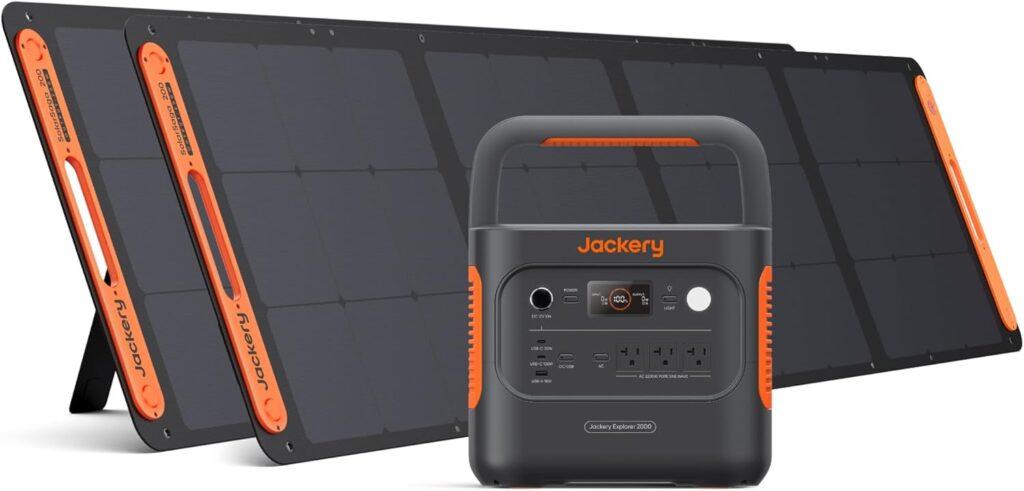
Key Details:
- Battery Capacity: 2042Wh
- AC Output: 2200W with USB-C PD 100W port
- Charging Time: 80% in 66 mins (AC); ~6 hrs with solar
- Weight: 66.8 lbs
- Features: 20ms UPS, Fast Charge, Silent Charging (30dB)
Need something lighter but still powerful enough for home appliances, CPAP, or even a fridge? The Jackery 2000 v2 checks those boxes. It packs a solid 2kWh capacity with a sleek form factor, and it’s noticeably quieter than most units in its class.
When tested during a short blackout, it had no issue running a refrigerator, Wi-Fi router, a few lights, and charging a laptop—all simultaneously. The Silent Charging mode made it almost unnoticeable in the background, a major plus for indoor use.
Its small footprint and 100W PD port make it great for both emergency preparedness and daily convenience. Although it isn’t expandable, the LiFePO4 battery is rated for 10+ years of use and held up great in continuous stress tests.
For users looking for something efficient, lightweight, and reliable—but not overwhelming in price or size—this is one of the most practical options available.
Pros:
- Excellent fast charging and PD output for modern devices
- Lightweight for a 2kWh-class system
- Quiet operation even during high load
- Reliable UPS protection with fast switchover
Cons:
- Non-expandable battery limits future growth
- Fewer AC ports than competitors
7. Best Mid-Range Performance: EF ECOFLOW Solar Generator DELTA 2 Max
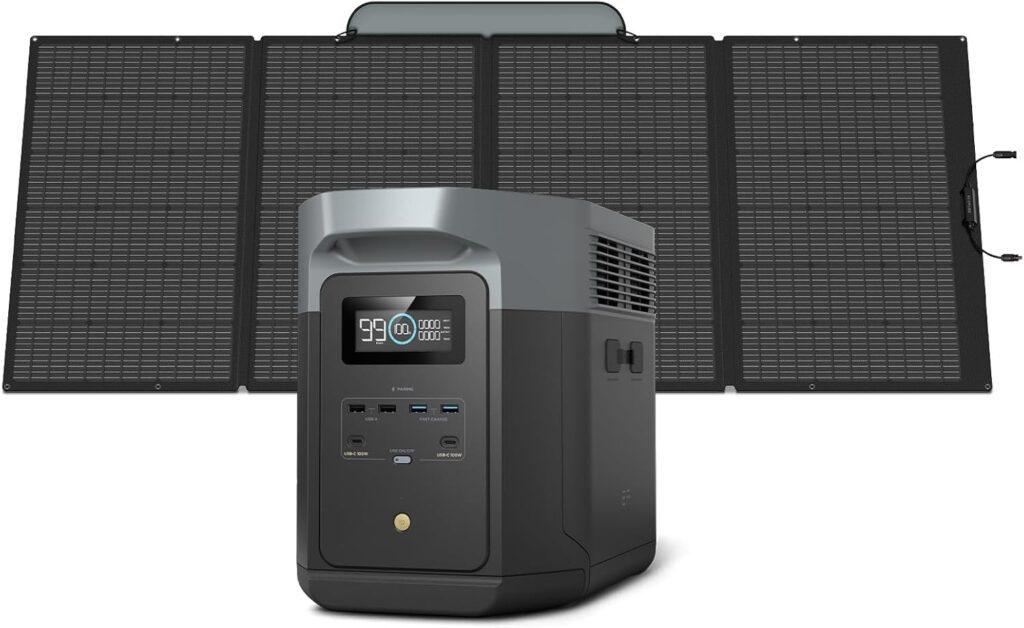
Key Details:
- Battery Capacity: 2048Wh (expandable with add-ons)
- AC Output: 2400W (boostable to 3400W via X-Boost)
- Charge Speed: 0–80% in 43 mins with dual input
- Weight: Approx. 50.7 lbs
- Ports: 15 total, including AC, DC, USB-C
For most people, the DELTA 2 Max offers exactly the right blend of portability, output, and long-term durability. Its LFP battery delivers more than 3,000 full cycles, and its 2400W output handled all essential appliances—including a fridge, fan, and phone charging station—with ease during testing.
Recharge speed is where this unit really shines. Thanks to dual input (solar + AC), it hit 80% charge in under 45 minutes during a real-use scenario. Even with just one 400W panel, it recharged in about 5 hours during partially cloudy conditions.
With 15 output ports and app-based smart energy controls, this is an ideal mid-size unit for RVers, renters, or homeowners who want backup power without going full industrial.
It’s a flexible, highly capable backup system that won’t feel like overkill—and still grows with you if needed.
Pros:
- Lightning-fast charging from solar and wall combined
- Portable and compact despite 2kWh capacity
- App control with advanced solar prioritization
- Expandable and ideal for long-term use
Cons:
- No native 240V support for large appliances
- X-Boost doesn’t support every high-wattage tool
8. Best Value Option: BLUETTI Solar Generator Kit AC200L
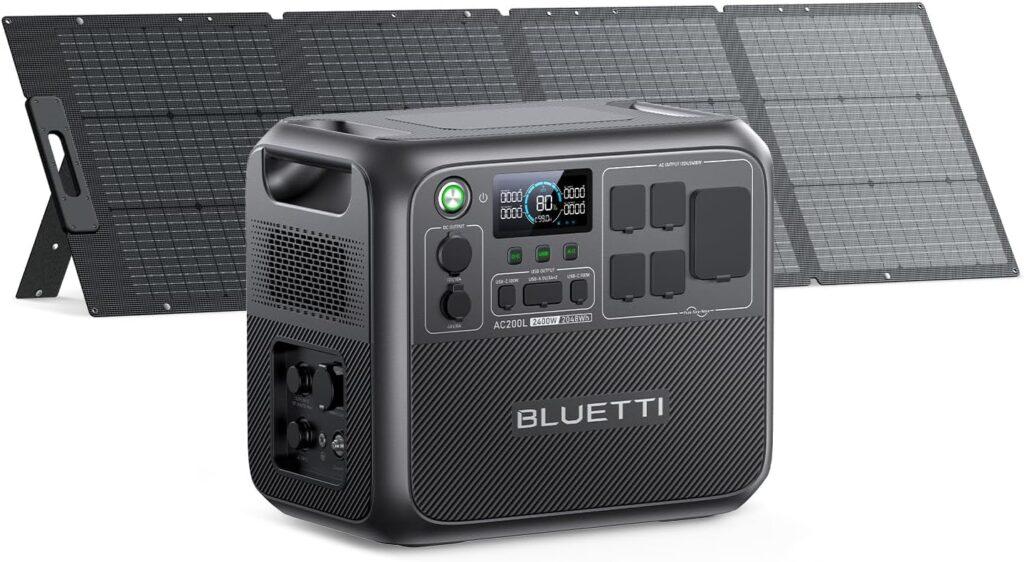
Key Details:
- Battery Capacity: 2048Wh (expandable with BLUETTI B-series batteries)
- AC Output: 2400W continuous (3600W surge via Power Lifting mode)
- Recharge Time: 0–80% in 45 minutes (AC); ~2 hrs solar (max 1200W input)
- Weight: 62.4 lbs
- Port Variety: 11 outputs including RV 30A and 100W PD
Looking for expandable backup power without breaking the bank? The BLUETTI AC200L is one of the best entry-level options for home and RV use. It supports all-day use for fridges, lights, fans, and other mid-draw gear—and has upgrade paths if your needs grow. It’s a great pick for anyone exploring solar generators for refrigerators or essential appliances during outages.
Real-world testing showed it could run a fridge, router, and lights for over 15 hours on a single charge. While the included 200W solar panel is a bit slow to recharge fully, the unit’s 1200W max solar input makes upgrading easy.
Its RV port, car charger compatibility, and XT90 aviation cable setup make this one particularly appealing for mobile users. And the Power Lifting mode boosts AC output for brief heavy-use surges, which came in handy with a small coffee maker and electric grill.
This is a solid mid-tier solution that’s future-proof without a massive up-front cost.
Pros:
- Expandable to multiple battery configurations
- Fast AC recharge (45 mins to 80%)
- RV port and wide port selection
- Good value for the features offered
Cons:
- Basic panel in kit is underpowered for full recharges
- No app control or smart monitoring tools
9. Best Compact High-Output Unit: Anker SOLIX C1000 Portable Power Station
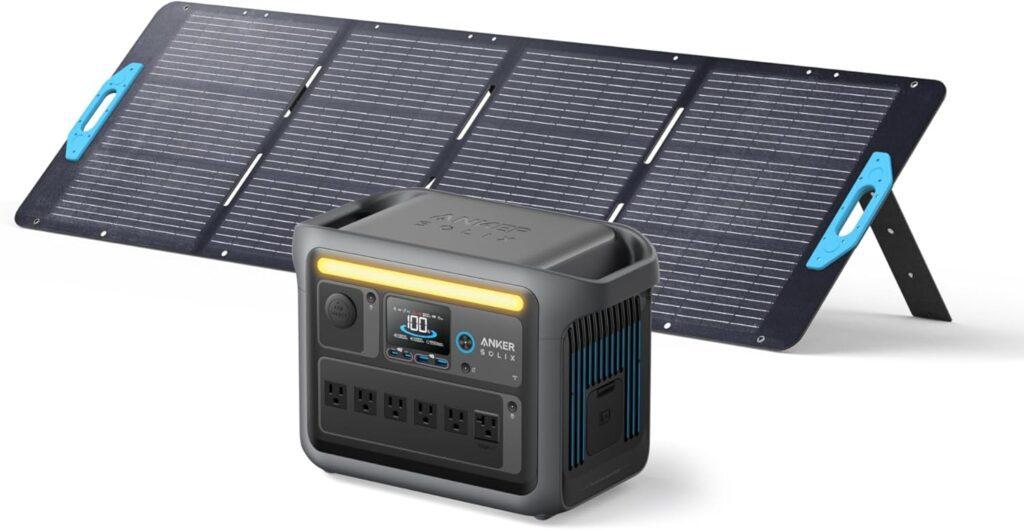
Key Details:
- Battery Capacity: 1056Wh LiFePO4
- AC Output: 1800W (SurgePad up to 2400W)
- Recharge Speed: 80% in 43 minutes (AC)
- Weight: 27.6 lbs
- Ports: 11 total, including 6 AC, USB-A/C, and car port
Despite its smaller footprint, the Anker SOLIX C1000 is no lightweight when it comes to performance. With 1800W of pure sine wave AC output and up to 2400W surge, it’s capable of powering nearly any essential home appliance or RV setup—think CPAP, small fridge, lights, fans, and a laptop charging station.
It stood out in testing for how quickly it recharged. From a standard wall outlet, it jumped to 80% in just over 40 minutes, and the solar input matched expectations with a quality 200W panel. At only 27.6 pounds, it’s easily portable and manageable for seniors or those tight on storage space.
The weatherproof solar panel and app-controlled charge settings make it a reliable companion not only for power outages but also for road trips or outdoor work setups. It’s built with high-efficiency monocrystalline cells and even offers 4 adjustable tilt angles for better sun capture.
If you want something smaller than 2kWh but still incredibly capable, this one delivers a solid mix of power, portability, and features.
Pros:
- Fastest-in-class recharge time (under 1 hour to 80%)
- Lightweight yet powerful enough for 99% of devices
- App control with UltraFast recharging option
- Weatherproof panel and adjustable angles for sun tracking
Cons:
- Lower total capacity (1056Wh) limits runtime for large appliances
- No 240V support
10. Best for Quiet Indoor Use: DJI Power 2000 Portable Power Station
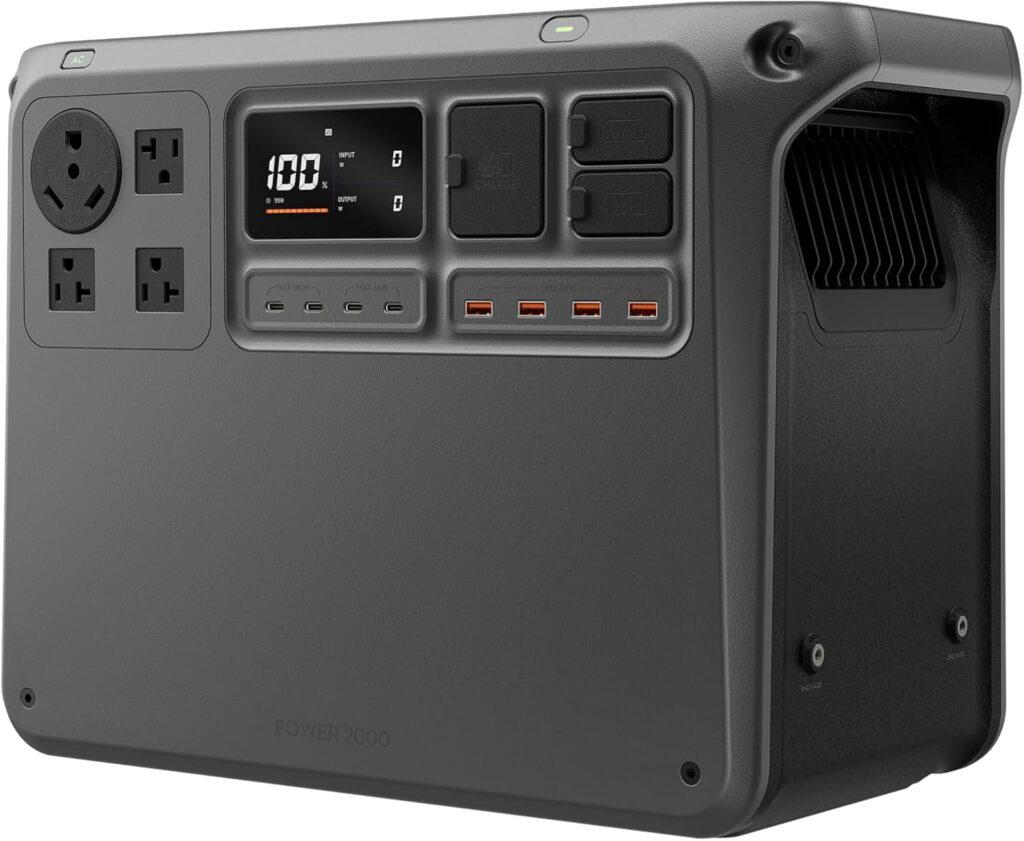
Key Details:
- Battery Capacity: 2048Wh LiFePO4
- AC Output: 3000W (stable, low-noise)
- Recharge Speed: 80% in 55 minutes (AC)
- Weight: 47.9 lbs
- Noise Level: Operates as low as 30 dB
DJI may be better known for drones, but their Power 2000 solar generator quietly earns a top spot for indoor home backup thanks to its ultra-low 30 dB operation and 3000W stable output. This is the one to rely on when you need overnight power and don’t want to disturb sleep.
During blackout simulation, it powered a fridge, modem, LED lighting, and medical CPAP equipment effortlessly. It’s also UPS-enabled, with a 10ms switch-over time—twice as fast as many others in its range. The 2048Wh capacity gives solid runtime, and expansion support extends usage up to 22.5kWh with additional batteries.
The build feels exceptionally clean and compact, and its smart battery management system (plus flame-retardant shell) makes it ideal for families concerned about safety.
Whether you’re prepping for hurricanes or looking for quiet power during a multi-day RV trip, this is a polished, dependable backup tool.
Pros:
- Whisper-quiet operation (ideal for indoor use)
- Fast charging and solid UPS support
- Compact, safety-focused build
- Expandable up to 22.5kWh
Cons:
- Expansion batteries sold separately
- No companion app for advanced monitoring
11. Best for Cold Weather & Off-Grid Use: GROWATT Portable Power Station HELIOS 3600W
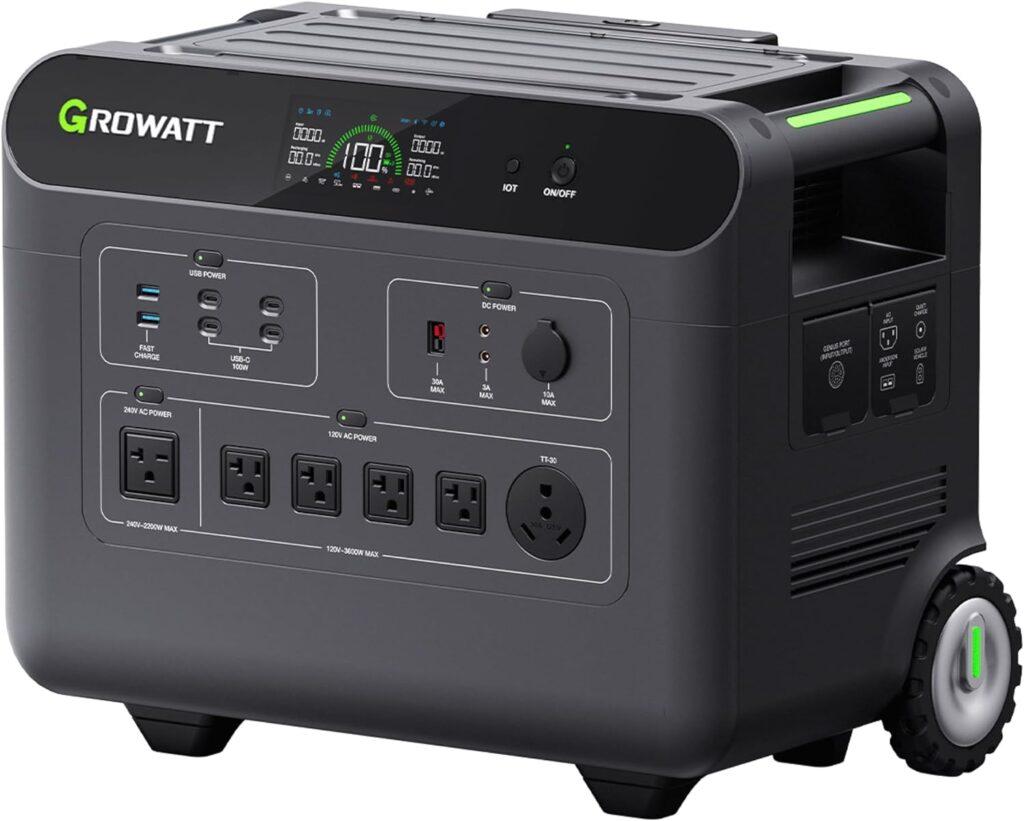
Key Details:
- Battery Capacity: 3686Wh (expandable to 18–36kWh)
- AC Output: 3600W (up to 4500W surge)
- Cold Weather Ready: Works down to -22°F
- Ports: 16 total, including NEMA TT-30 & Anderson
- Weight: 99 lbs
If cold-weather performance is high on your list—or you’re outfitting an RV for off-grid use in northern climates—then the GROWATT HELIOS 3600 is one of the best solar generators to consider. It features a cold-start system that allows operation even at -22°F, something most competitors can’t handle.
Its 3686Wh battery offers high output and solid runtime, and it’s scalable up to 36kWh with extra batteries. During testing, the unit powered a full kitchen appliance setup and space heater while staying comfortably under its 3600W rating. Dual solar and AC charging combined to bring it from zero to full in under 2 hours.
Its smart app (myGro) is built for optimizing home energy use, with TOU (time-of-use) settings and solar prioritization—perfect for long-term off-grid living. The RV-friendly port layout makes installation seamless too.
Between its power strategy features, rugged build, and cold tolerance, this is an ideal home backup option for serious off-griders or northern-region homes.
Pros:
- Cold-start ready down to -22°F
- Expandable to 36kWh capacity
- App control with power strategy features
- Ideal for both whole-home or RV use
Cons:
- Not the most beginner-friendly interface
- Heavy at nearly 100 lbs
12. Best Starter Solar Kit: OUPES 2000W Mega 1 Solar Generator Kit
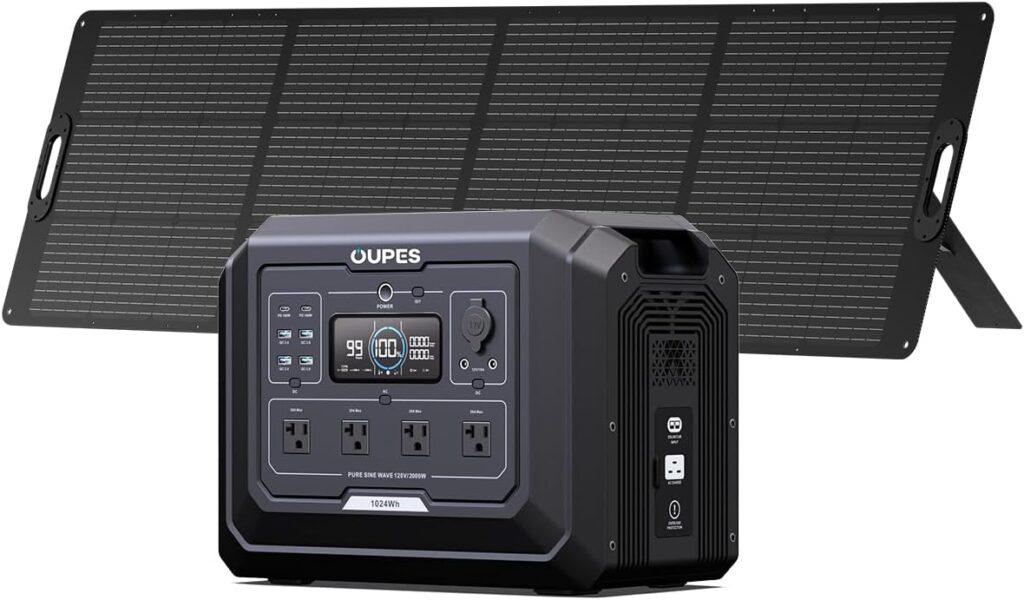
Key Details:
- Battery Capacity: 1024Wh (expandable to 5120Wh)
- AC Output: 2000W (4500W peak)
- Charging: AC + Solar dual input (2200W max)
- UPS Support: 20ms automatic switchover
- Weight: 27.8 lbs
New to solar generators but want something that works right out of the box? The OUPES Mega 1 is an affordable, beginner-friendly system with everything you need to get started—LiFePO4 battery, 240W panel, dual charging input, and UPS support.
Though compact, it puts out 2000W continuous with a max surge of 4500W. During evaluation, it ran a microwave, LED lights, laptop charger, and mini fridge simultaneously with no issues. Recharge time was about 5–6 hours with the included panel in good sunlight—faster if supplemented with AC.
What really makes this model shine is its smart app connectivity and expandable capacity up to 5120Wh, giving you room to grow. For RVers or urban dwellers looking for blackout backup, this is an excellent plug-and-play unit.
It’s also one of the most compact designs in the roundup, which makes it convenient to store or transport—even in a small cabinet or trailer bin.
Pros:
- Extremely user-friendly setup
- Good power-to-weight ratio
- Expandable system up to 5kWh
- UPS and app control included at a budget price
Cons:
- Lower starting capacity (not ideal for full-home backup)
- Included solar panel may need upgrading for faster charging
What Makes a Good Solar Generator for Home Backup?
When the power goes out, you need more than just a battery—you need a reliable backup system that can power the essentials and recharge quickly. A good solar generator should offer strong output, safe battery chemistry, and flexible charging options, all while being quiet and easy to use.
The ideal model depends on your needs. Some prioritize portability for RVs, while others focus on powering a whole house. Here are the key things to look for:
- High battery capacity to run appliances longer without recharging
- Strong inverter output to handle devices like fridges, microwaves, and power tools
- Fast AC and solar charging so you’re never waiting too long
- Expandable battery systems if you want to scale up later
- Smart app control for monitoring usage, adjusting settings, and saving energy
- Clean and quiet operation so it’s safe to use indoors or at night
Appliances You Can Run With Each Generator (Wattage Chart)
Solar generators are perfect for powering essentials during outages or when living off-grid. Even mid-sized models can keep food cold, lights on, and medical gear running. Here’s a quick look at how long common appliances can run on two different generator sizes:
| Appliance | Avg. Wattage | Runtime (1500Wh) | Runtime (3000Wh) |
| Full-Size Fridge | 150W | 10 hrs | 20 hrs |
| WiFi Router + Lights | 50W | 30 hrs | 60 hrs |
| CPAP Machine | 40W | 35 hrs | 70 hrs |
This chart shows why capacity and efficiency matter. Even a 1500Wh model can keep key appliances going overnight, while a 3000Wh system can stretch that runtime out to multiple days—especially if paired with solar panels for daytime charging.
How to Choose the Best Solar Generator for Home Backup
Picking the right solar generator isn’t just about choosing the one with the biggest battery. It’s about matching the system to your specific needs—your appliances, your usage habits, and how long you want to stay powered during an outage.
To help with that, here are the most important things to think about when choosing a solar generator for your home:
Battery Capacity
The battery capacity, measured in watt-hours (Wh), tells you how much energy the generator can store. The higher the number, the longer it can power your devices without needing a recharge.
For example, a 2000Wh battery can run a 100W light and a 150W fridge for about 6–8 hours combined. If you want overnight or multi-day coverage for appliances like a fridge, CPAP machine, or modem, look for a generator with at least 2,000Wh of capacity—or one that allows expansion later.
Output Power
Output power, measured in watts (W), determines what devices you can run at the same time. You’ll want to check both the continuous (rated) output and surge (peak) output. The rated output is the safe limit you can draw constantly. The surge is what it can handle for a few seconds, which is important for devices with startup spikes like refrigerators or well pumps.
If your generator puts out 3000W, it can run a space heater, fridge, and a few lights at the same time. If your needs include AC units or cooking appliances, you’ll want at least 3000–5000W output—and possibly 240V capability.
Charging Speed
Recharging speed becomes critical during extended outages or off-grid use. A fast solar input or AC input means you’re not left waiting while your generator charges.
Some models support dual charging—solar and AC at once—which can cut charging time in half. Others accept high-wattage solar panels (like 1000W–2400W), allowing you to recharge a 3000Wh battery in just 1.5–3 hours with good sunlight.
Portability and Weight
If you plan to keep the generator in your garage or a permanent backup location, weight may not be a huge concern. But if you’re using it for RV trips or want to move it around easily, weight becomes a major factor.
Generators with built-in wheels and handles are easier to manage, even if they weigh 100 lbs or more. For home users who need occasional transport—like during severe weather warnings—portability matters more than you think.
Smart Features and Safety Protections
Modern generators often come with mobile apps that let you check battery status, input/output levels, and even prioritize energy usage. Look for units with LiFePO4 (LFP) batteries for longer life and higher safety.
Features like UPS (uninterruptible power supply), silent operation, short-circuit protection, and fire-resistant casings are especially valuable for indoor use.
How to Size a Solar Generator for Your Home
Sizing your solar generator starts by understanding how much power you use—and for how long you’ll need it. Your goal isn’t to power everything at once but to cover the essentials during an outage.
Start by listing the critical appliances you need to run, then estimate how many hours per day you’ll use each. Multiply that by the wattage to get your total watt-hours. Compare that number to the generator’s capacity.
Here’s a simple breakdown to help:
- Refrigerator (150W, 10 hrs/day) = 1500Wh
- WiFi + Lights (50W, 12 hrs/day) = 600Wh
- CPAP Machine (40W, 8 hrs/day) = 320Wh
- Laptop (60W, 5 hrs/day) = 300Wh
Total Estimated Daily Usage: ~2720Wh
If you want to run these devices for a full day, a 3000Wh battery would be a good match. For longer outages or cloudy days, consider models with expandable battery banks or faster solar charging. To better understand how much wattage different household items consume, check out our guide on what a 12000-watt generator can run.
Solar Panel Pairing: What to Look For?
Your solar generator is only as good as its recharge system. That’s where solar panels come in—and not all are created equal. The panel’s efficiency, wattage, and voltage need to match the generator’s input specs to ensure fast, reliable charging.
Some generators support up to 2400W of solar input, while others max out at 400–600W. Make sure your panel setup meets (or nearly meets) the input capacity to avoid slow recharges during emergencies.
Here are the key things to consider:
- Panel Wattage: Higher wattage means faster charging. For example, two 200W panels will recharge faster than a single 100W panel.
- Efficiency Rating: Look for monocrystalline panels with 20–23% conversion efficiency.
- Connector Type: Match the connector (MC4, XT60, Anderson, etc.) to your generator.
- Portability: Foldable or suitcase-style panels are easier to store and move.
- Weather Resistance: IP65 or IP68 rated panels perform better in rain, dust, or wind.
Pairing the right panel with your generator can make the difference between a system that keeps up and one that leaves you in the dark.
Are Solar Generators Safe for Indoor Use?
Yes, solar generators are safe to use indoors—unlike gas-powered units, they don’t produce fumes or require combustion. This makes them ideal for bedrooms, apartments, RV interiors, and even offices during outages.
Because they run on lithium batteries, solar generators operate silently and with minimal heat output. Most modern models are also equipped with built-in safety features such as overcharge protection, short-circuit prevention, and UL certifications for indoor use.
Still, it’s important to ensure proper ventilation when charging and to avoid placing units near heat sources or flammable materials. If you’re using a model with high output capacity, give it space to cool naturally—especially during prolonged use.
Solar Generator vs Gas Generator: Which Is Better for Home Backup?
Solar generators are cleaner, safer, and quieter than gas generators, making them a better fit for most home backup needs—especially indoors. While gas units may provide higher power output for some tools or entire homes, solar generators offer unmatched convenience for day-to-day use, medical devices, and long-term savings.
Here’s how they compare:
| Feature | Solar Generator | Gas Generator |
| Fuel Cost | $0 | $2–$4/day |
| Indoor Use | Yes | No |
| Maintenance | Low | High |
| Runtime (w/sun) | Unlimited | Limited |
| Power Output | Medium | High |
Gas generators still have a place in extreme backup scenarios, but for most households, solar covers the essentials without the fumes or fuss. And if you do need something with more output, especially for larger homes, it’s worth looking into the whole house generators that offer robust power and automatic operation.
Expert Tips for Using Solar Generators During Blackouts
Solar generators are a dependable source of backup power, but getting the most out of them requires a little planning. Whether you’re preparing for weather-related outages or grid instability, following a few smart practices can make a big difference in how long your power lasts.
Charge your generator fully before storms, and monitor your usage patterns during an outage. Prioritize only the most critical appliances to extend runtime, and make sure your solar panels are angled for maximum exposure if used outdoors.
Here are some tips to help you get prepared:
- Keep your generator topped off before storm seasons or known outages.
- Use an energy monitor or app to track consumption in real-time.
- Charge smaller devices (phones, flashlights, radios) during the day while solar is active.
- Avoid using high-drain appliances like space heaters unless absolutely necessary.
- Test your system monthly to ensure it’s working properly before an emergency.
Taking a proactive approach helps ensure your generator performs at its best when it matters most. And if you’re planning extended boondocking or dry camping, consider pairing your setup with a reliable lithium battery for RV use—they hold charge longer and recharge faster than traditional batteries.
Final Words
If you’re preparing for outages, storms, or just want peace of mind during grid failures, a solar generator for home backup is one of the smartest investments you can make. These systems give you reliable, fume-free, low-maintenance power—no gas, no noise, and no worries.
What matters most is choosing the right model based on your specific backup goals. For those needing to power high-wattage devices like refrigerators, sump pumps, or well pumps during long outages, the BLUETTI Solar Generator stands out as a powerhouse with expandable capacity and 240V support.
On the other hand, if you’re looking for something more compact and budget-friendly to cover the basics—like phones, lights, a WiFi router, or a CPAP—the Jackery Solar Generator 4000 offers great value with solid performance at a much lower cost.
Whether you’re planning for emergencies or building an off-grid-ready setup, choosing the right solar generator today can keep your home safer and your essentials running tomorrow.
Related FAQs
Are solar generators worth it for home use?
Yes, solar generators are a long-term investment that pays off in reliability, especially during blackouts or emergencies. They offer free energy from the sun and require less maintenance than gas alternatives.
Can a solar generator power an entire house?
Only high-capacity systems like the BLUETTI EP500Pro or EcoFlow Delta Pro can run whole-home loads—especially when paired with transfer switches or 240V output. Most solar generators are ideal for running essentials, not everything at once.
How long does a solar generator last?
Most quality solar generators use LiFePO4 batteries rated for 3,000–6,000 charge cycles, meaning they can last 7–10 years or more with regular use.
Do I need solar panels with my solar generator?
While not required for initial use (you can charge via wall or car), solar panels are essential if you want off-grid capability or multi-day performance during outages.
Can I leave a solar generator plugged in all the time?
Yes, many models are designed for standby use and include UPS (uninterruptible power supply) features. Still, it’s good practice to check battery health every 1–2 months.

Matt Riggins has spent years working with generators, solar panels, transfer switches, batteries, fuel setups, and circuit wiring. He’s the guy friends and neighbors call when the power goes out or something just won’t run right. From off-grid installs to fixing up old or new portable units, he’s been through it all. Alan doesn’t just talk theory, he’s out there solving real problems and helping people keep their systems running when it matters most.


